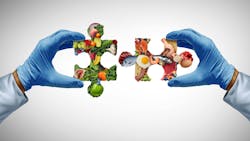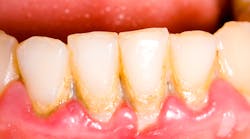The advantages of discussing nutrition in the dental setting
Contributing authors:
Annelise Collins, MBA, RD
Ellen R Guritzky, MJS, RDH, FADHA
Alpa Shah, MS, RDN
It has long been said that the standard American diet has led to a nation of overfed and undernourished people. We often follow diets of ease and convenience. The United Nations published a report in 2022 detailing how Western diets average 3,540 daily calories,1 while the recommendation remains between 1,600 and 3,000 based on individual needs.2 Even those who adhere to the recommended caloric intake may not meet nutritional needs.
According to the latest United States Department of Agriculture (USDA) and United States Department of Health and Human Services (HHS) dietary guidelines, Americans lack sufficient daily fruit and vegetable intake.2 Three quarters of Americans do not eat a single piece of fruit daily, and most do not meet the minimum weekly vegetable standard.3 Ninety-eight percent of Americans do not eat the recommended amount of whole grains.2 Low intakes of fiber, vitamin D, calcium, and iron are noted as a particular concern in the 2020-2025 dietary guidelines.3
Information barriers
Nutritional information can be confusing for patients. Many face barriers that make reliable information from trusted sources difficult and burdensome to obtain. Patients turn to their doctors as reliable sources, but conversations with a primary care physician (PCP) may feel impossible for some.
Many of our patients do not see their PCP regularly. This is often due to fear. In other cases, getting an appointment to see their doctor may take weeks or months, especially in underserved communities. Patients who visit their doctor regularly may not have the opportunity to discuss dietary recommendations, as physicians often cannot spend significant time with each patient. When a physician does discuss nutrition, the patient may take little away from the conversation due to weight stigma or bias. Patients often postpone or cancel appointments at medical offices to avoid being weighed for fear of being embarrassed or judged.4
Many people search online for nutritional assistance. Good resources exist, but there is an abundance of misleading content from websites and social media influencers. A 2023 systematic review revealed that much nutrition-related information on these platforms is either misleading, poor quality, or potentially harmful.5
Advantages of the dental setting
Dental offices have fewer barriers to initiating the nutrition conversation with patients. For example, they do not weigh adult patients, and patients can usually visit their dental offices with greater ease. Some signs and symptoms of poor nutrition may only be observed by a dental professional, as most medical office visits don’t include a thorough examination of the mouth.
The ADA recognizes this advantage and there is already a dental code (D1310) to provide nutritional counseling for control and prevention of oral disease. The frequency of dental visits is also an advantage. According to the Centers for Disease Control and Prevention, 65.5% of American adults and 86.9% of children visit their dental office one to four times annually.6
Hygienists also typically spend 45 to 90 minutes with each patient. Building personal relationships and trust over repeated visits is a great way to help guide patients toward healthy choices. We already do this with patients by making recommendations to improve their oral health; it’s time we start adding nutrition to our educational services.
Note that dental professionals have equal or greater nutritional requirements in their programs when compared to medical doctors. Most medical schools do not have a formal nutrition course; instead, they nestle nutrient-based content in classes such as biochemistry, pathology, and physiology.7 In contrast, the Commission on Dental Accreditation (CODA) requires all dental hygiene programs to have at least a three-hour nutrition course in addition to the biomedical science, anatomy, physiology, and pathology classes.8
Observations in the dental setting
Dental providers observe many things that could lead to a discussion about nutrition. The first thing we do at every appointment is review medical histories, medications, and supplements. In most states, dental hygienists are required to take blood pressure. Many health conditions can benefit from either proper nutrition or the addition of supplements.
When radiographs are taken and patients are diagnosed with multiple caries, it’s easy to discuss reducing sugars and acids in the diet. Sometimes, calcified atherosclerotic plaques appear in panoramic radiographs. An office policy should be in place to refer a patient to their PCP, and to initiate a conversation about diet by explaining the disease process and providing basic nutritional advice, such as limiting high-cholesterol foods or triglycerides. This helps prepare the patient to hear lifestyle recommendations from a second health-care provider.
Bleeding, gingivitis, and worsening periodontal disease can sometimes be attributed to a lack of proper vitamins and minerals. Periodontal patients should know the role of nutrition in periodontitis, and how to obtain essential nutrients through their diet.
Developing a strategy
Starting a conversation about nutrition can be difficult. You need to know your patients and their motivations. Change can be overwhelming, and making too many recommendations can result in no change at all. When suggesting a first step, a patient may be more likely to add a serving of vegetables or a multivitamin rather than eliminate something.
Sit the patient upright so they can see your findings and be an equal part of the discussion. Discuss their disease process and how to manage or reverse it with nutrition and supplementation. Resources such as brochures or websites are available through the American Heart Association, the American Diabetes Association, and the USDA. Document your discussion and note in their chart to follow up at the next visit.
Putting it together
Dental professionals have a unique advantage when it comes to discussing nutritional needs with patients. Our patients see us more frequently, for longer periods of time, and typically enjoy seeing the same providers at every appointment.
Patients trust us with their mouths, but it’s time we connect the mouth to the rest of the body. Our knowledge of the human body allows patients to benefit by explaining how nutrition plays a vital role in preventing and treating disease. We have the expertise and valuable insights to make suggestions to enhance patients' current nutritional intake.
Editor's note: This article appeared in the October 2024 print edition of RDH magazine. Dental hygienists in North America are eligible for a complimentary print subscription. Sign up here.
References
1. Once again, US and Europe way ahead on daily calorie intake. News United Nations. December 12, 2022. Accessed May 20, 2024. https://news.un.org/en/story/2022/12/1131637
2. Dietary Guidelines for Americans, 2020-2025. U.S. Department of Agriculture and U.S. Department of Health and Human Services. December 2020. https://www.dietaryguidelines.gov/
3. Standard American diet. Nutrition facts. Accessed May 20, 2024. https://nutritionfacts.org/topics/standard-american-diet/
4. Amy NK, Aalborg A, Lyons P, Keranen L. Barriers to routine gynecological cancer screening for White and African American obese women. Int J Obes (Lond). 2006;30(1):147-155. doi:10.1038/sj.ijo.0803105
5. Denniss E, Lindberg R, McNaughton SA. Quality and accuracy of online nutrition-related information: a systematic review of content analysis studies. Public Health Nutrition. 2023;26(7):1345-1357. doi:10.1017/S1368980023000873
6. Oral and dental health. Centers for Disease Control and Prevention. May 22, 2024. Accessed June 3, 2024. https://www.cdc.gov/nchs/fastats/dental.htm
7. Millard E. How nutrition education for doctors is evolving. Time. May 24, 2023. Accessed June 3, 2024. https://time.com/6282404/nutrition-education-doctors/
8. Accreditation standards for dental hygiene education programs. Commission on Dental Accreditation. 2023. Accessed August 5, 2024. https://coda.ada.org/standards
About the Author
Breezy Briana Bonney, MS, BSDH, RDH
Breezy Briana Bonney, MS, BSDH, RDH, is a dental hygienist with a bachelor’s degree in dental hygiene from Texas A&M College of Dentistry and a master's degree in medical nutrition from Arizona State University. She is passionate about educating patients and clinicians on dental health, the oral-systemic link, and nutrition. When Breezy is not working, she enjoys training for her next half marathon or working out at OrangeTheory Fitness with her husband.


